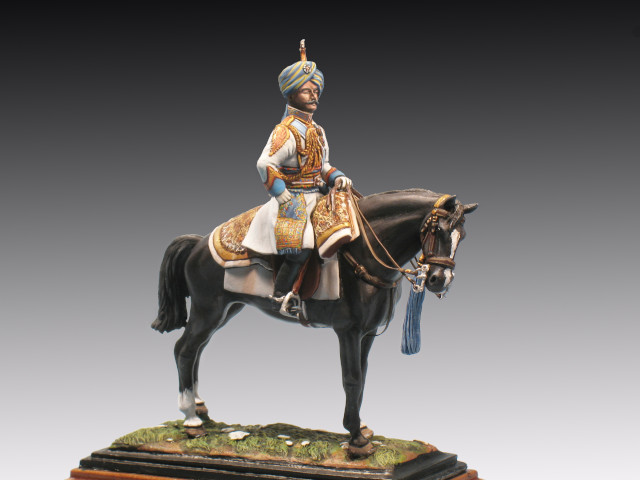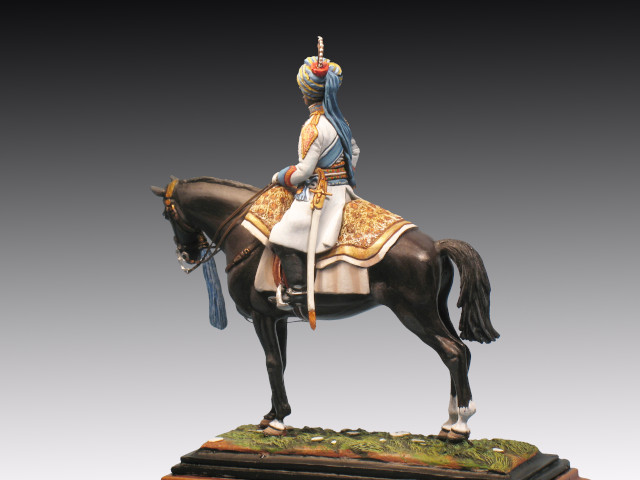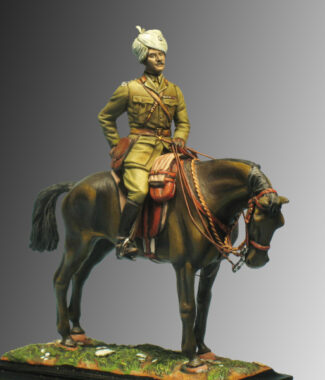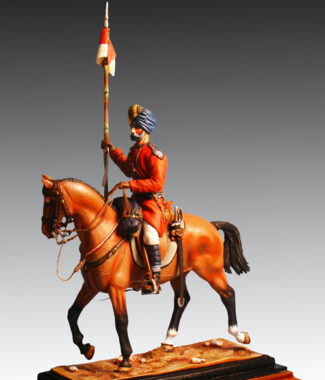You must be logged in to post a review.
Sir Pratap Singh – 1901
€68.00
Figure to assemble and paint
Ref.: 20 – IA
Weight: 170 grs.
Material: White Metal
Number of Pieces: 16
Historical Review:
Lieutenant-General Maharaja Sri Pratap Singh Sahib Bahadur of Idar, GCB (Grand Commander of the Orden of Bath), GCSI (Grand Commander of the Star of India), GCVO (Grand Commander of Victorian Order); (22 October 1845 – 4 September 1922) was a career British Indian Army officer, Maharaja of the princely state of Idar (Gujarat) and heir to Ahmednagar (Now Himmatnagar) from 1902 to 1911, when he abdicated in favor of his adopted son.
The prince who would become a great warrior of the British Empire was born on 22 October 1845. He was the third son of His Highness Maharaja Sir Takht Singh of Jodhpur (1819-13 February 1873) the Maharaja of Jodhpur, and his first wife, Maharani Gulab Kunwarji Maji Sahiba. He was educated privately, and little is known of his early life.
From 1878 to 1895, Pratap Singh served as Chief Minister for Jodhpur following his father’s death in 1873 and his eldest brother’s succession to the throne. After his brother’s death in 1895, Pratap Singh (by now Sir Pratap Singh) served as regent for his fifteen-year-old nephew and heir to the Jodhpur gadi -throne- until 1898, then again for his grandnephew from 1911 to 1918 and finally for his second grandnephew from 1918 until his own death in 1922. In total, Pratap Singh had served four rulers of Jodhpur for over four decades. He travelled to Europe often and was close to Queen Victoria and her family, serving as aide-de-camp to Edward VII from 1887 to 1910. He was especially close towards his son, the future George V of the United Kingdom.
Commissioned in the Jodhpur Risalda in 1878, Pratap Singh served during the Second Afghan War and was Mentioned in Despatches. He was promoted to Lieutenant-Colonel in 1887, served under General Ellis in 1897 and served in the Tirah Campaign in 1898 under General William Lockhart, during which he was wounded. Promoted to Colonel the same year, he commanded the Jodhpur contingent during the Boxer Rebellion and promoted to an Honorary Knight Commander of the Order of the Bath (KCB). He was promoted to Major-General in 1902, and in 1903 was made honorary commandant of the Imperial Cadet Corps (1) under the Viceroy of India Lord Curzon. Even as an elderly man of 70, Sir Pratap commanded his regiments heroically during the First World War in France and Flanders from 1914-1915 and in the Palestine Mandate at Haifa and Aleppo. He was promoted to Lieutenant-General in 1916.
In 1911, Sir Pratap had abdicated the gadi of Idar in favour of his adopted son and nephew, Daulat Singh. Following his wartime service and a final stint as Regent of Jodhpur, Sir Pratap Singh died at Jodhpur on 4 September 1922, one month shy of 77.
The figure is wearing the very luxurious dress uniform worn by cadets and teachers. It consisted of a white kurta (tunic), in this case lavishly decorated with gold embroidery on the shoulders and sleeves. This white colour contrasted with the blue of the sashes and turbans, which was adorned with a small crimson feather duster and a sort of golden feather in the shape of a wing. In the case of Sir Pratap, the jewellery (brooch, pearls and cameo) should be added.
NOTE (1)
The Imperial Cadet Corps (1901–1917) was a cadet corps or military school founded exclusively to give officer training to the princes and gentlemen of British India. It was founded in November 1901 under the direct surveillance of Lord Curzon at Meerut and Dehradun. Major D. H. Cameroon was made its first commandant and Maharaja Pratap Singh of Idar was made its Honorary Commandant. The youths between 17 and 20 years were selected and admitted as Imperial Cadets; their education was to be at any one of the Chief’s colleges at Rajkot, Indore, Lahore, Ajmer or Raipur. The selected cadets had to join the corps at Meerut or Dehradun. Though the ICC failed in course of time and was closed in 1917, it did, however, set the precedent for the training of native officers in India, which resulted in the founding of the Indian Military Academy at Dehradun in 1932.








Reviews
There are no reviews yet.